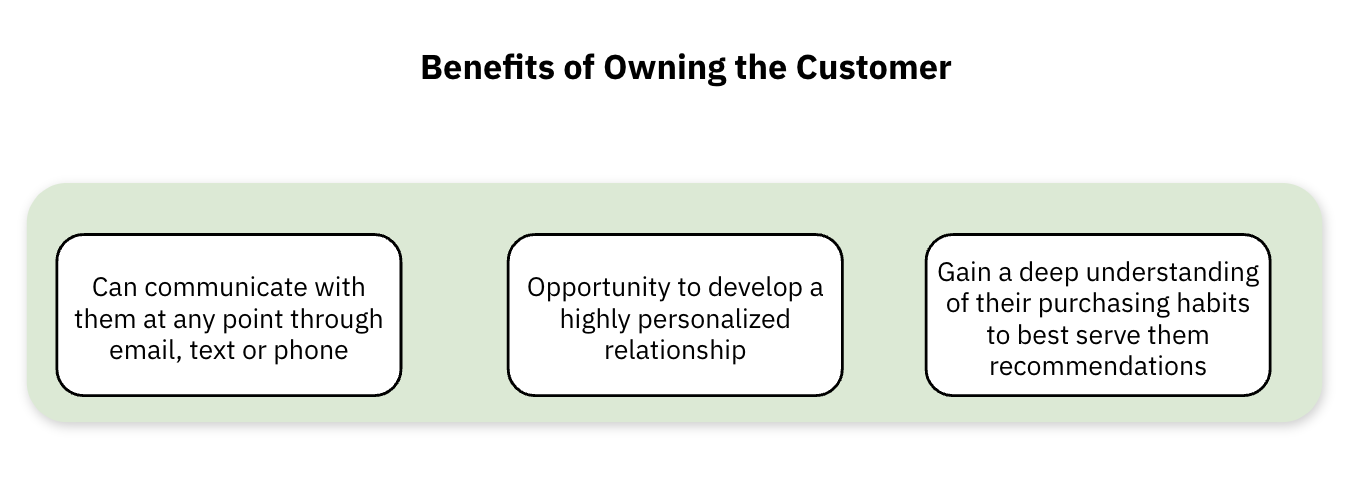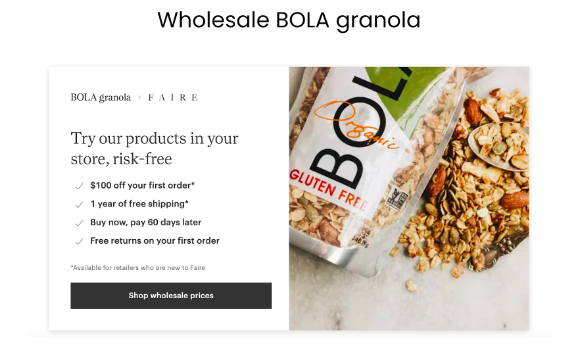Strategies to Build an Owned Retail List
No matter what type of business you operate, having a direct line of communication with your customers is essential. And this is especially true when dealing with retailers. Retailers have many options when it comes to stocking their stores, which makes developing a relationship with them vital. If you have any sort of intermediary that gets in the way of you communicating with your retailers, it could hinder your ability to develop a lasting relationship with them. And developing a lasting relationship with your retailers matters because repeat customers spend 67% more than new customers.
This is why it’s more important than ever for brands to “own” their customers - for both the direct to consumer (DTC) and wholesale channels. When you own your customers, you can communicate directly with them at any point, while also knowing vital information, such as how much money they have spent, what products they have purchased and when they have made purchases. All of these elements factor into you (the brand operator) being able to communicate smarter and faster with these retailers, which over time will grow your business.
We understand that marketplaces like Faire and Mable make it easy for you to access a wide array of retailers and take some of the wholesale operations work off your plate. However, they also come at a hefty cost to your business [link to Hunter’s article]. When you own your customers, you can not only communicate with them more freely, without any potential marketplace getting in the way of your relationship - but you can also operate more profitably. Also, by owning the relationship, you protect yourself against the marketplace potentially shutting down (which has happened to a few prominent marketplaces) and losing all of your contacts from the marketplaces.
Curious to understand what you can do to own more of your retail relationships? Read on to learn more!
Redefine How You Think About Wholesale on Your Website
With marketing costs increasing exponentially, any traffic you get on your site, should stay on your site. And this is especially true when an interested retailer is on your site.
Instead of pushing your site traffic to a marketplace (like Faire or Mable), we suggest keeping them on your site by not even giving them the option to purchase your products on these marketplaces. When you send traffic to a third party site, you are essentially waiving your right to own the customer right off the bat. This means that if your retailer leaves your site and buys your product on a marketplace, you have less control over the relationship from the outset, not to mention being stuck paying high commission fees.
To keep your site traffic on your site, invest in creating a strong wholesale experience on your site. What exactly does this look like?
Develop a clear and compelling reason as to why retailers should stock your product in their stores from your wholesale page.
Create an easy to fill-out wholesale application.
Closely monitor the wholesale applications that come in by having a dedicated staff member monitor and respond to all inquiries to minimize wait times.
Consider adding retailer testimonials on your wholesale page that speak to your impact on their store sales - you do this for your DTC business, why not do it for your wholesale business.
Don’t feel limited by these suggestions, as these are just thought starters. No matter what tactics you plan to take to manage your retailers, remember that it’s important to treat your wholesale business the same way that you treat your DTC site, with a carefully crafted strategy.
Prospect Target Accounts
Marketplaces offer a great “pull” impact for your business, meaning retailers are coming to you (the brand) to place orders. The downside is that some retailers who discover and purchase from you on a marketplace may not be a good fit for your brand, meaning that they won’t reorder from you if the products don’t sell. You have less control over who is buying your products on marketplaces, so spend more time “pushing” your product into target accounts that have a better chance of becoming long-term, valuable customers.
You know your brand better than anyone else and know what types of accounts will sell your product well long-term. Putting in the effort up front to prospect and reach out to target accounts will yield more high-value retailers. A retail target of yours will be more likely to reorder from you since the product will likely sell well, given that you are familiar with the types of customers that shop with the retailer.
How do you find and prospect target accounts? Here are some pointers:
Research which retailers carry your competitors and reach out to them directly to understand if they would be interested in learning more about your brand and product offerings.
Define the type of store that you think would do well with your brand. For example, if you are an athletic sock brand, odds are that a running store would be a target account of yours. Research all of the running stores in a particular area and see which ones would be a good fit for you to target, and reach out to them.
Network with like minded brands. Perhaps you know of some brands that don’t sell competitive products to you that are in some of your target accounts. Ask them to introduce you to the retailer.
Prospecting target accounts takes more time, energy and focus than just listing your products on a marketplace. But anything worthwhile usually takes work! We are big believers in putting the time in up front to establish your own set of retail accounts up front will set your brand up for sustainable growth - that you own.
Use Marketplaces as a Medium to “Own” the Relationship
We understand that marketplaces are a pillar of many brands' wholesale business, so it’s important that we clarify that we aren’t saying to ditch them entirely. Instead, we suggest using them strategically. Most marketplaces offer strong incentives for retailers to conduct business with you for their first year of doing business with you - for example they offer free shipping and net 60 payment terms - both of which are very attractive to both brands and retailers. However, what happens after that year is over? Those incentives go away and you are left trying to figure out who pays for shipping, what payment terms are acceptable, AND still paying that hefty commission.
Knowing this, use the first year that a retailer is with you on a marketplace to take advantage of the benefits that the marketplace offers. And over the course of that year, begin to establish a direct connection with them, with the goal of taking the relationship off of the platform to manage them directly.
Here are some tactics and strategies to take in order to do this:
After a new retailer is onboarded, reach out to them through the marketplace platform to introduce yourself to them and provide your email address and phone number - through the context that if any issues arise with their order that you are there to help them.
Think about creating different packaging on the products that you sell in a marketplace that provides your direct contact information in the event the retailer (or retailers customers) need to get in touch with you directly.
Use flashpoints throughout the year (for example the holidays) as an excuse to reach out directly to your retailers. Leverage the communication tools on the marketplaces as an extension of email and try to establish a human connection with them through the marketplaces.
At the end of the day, regardless of where you conduct business, personalized communication goes a long way in establishing a long-term relationship. So despite the fact that you don’t “own” the relationship when transacting through a marketplace, take advantage of the year full of incentives that marketplaces give you to try to build a personalized relationship with your retailers.
Taking these steps now will set your business up for long-term success, while also protecting you from a potential large revenue loss if something were to change with your marketplace. We are firm believers that owning your retail relationships will become a must for all brands within the next few years - so start taking action now to protect your business to own your growth.
Want to learn more about how Vanik can help you streamline your owned retail relationships? Join our waitlist and we’ll be in touch to chat with you further.

